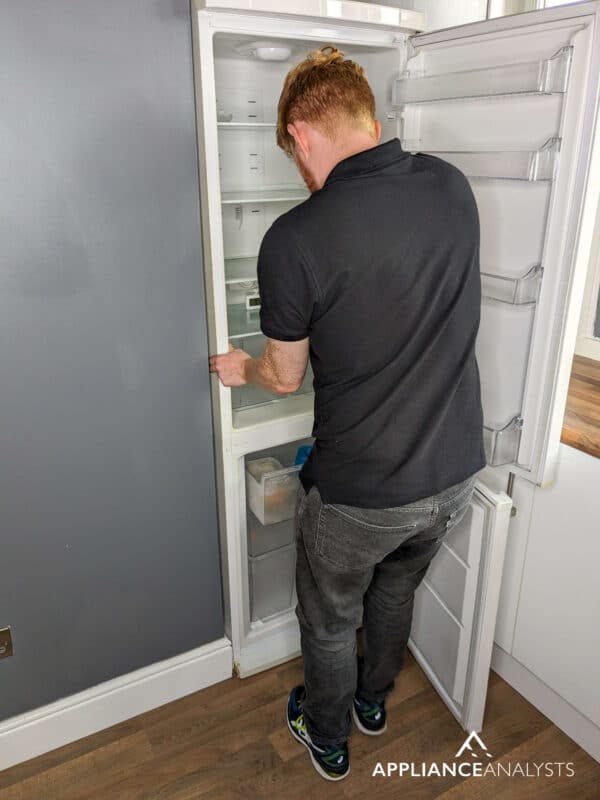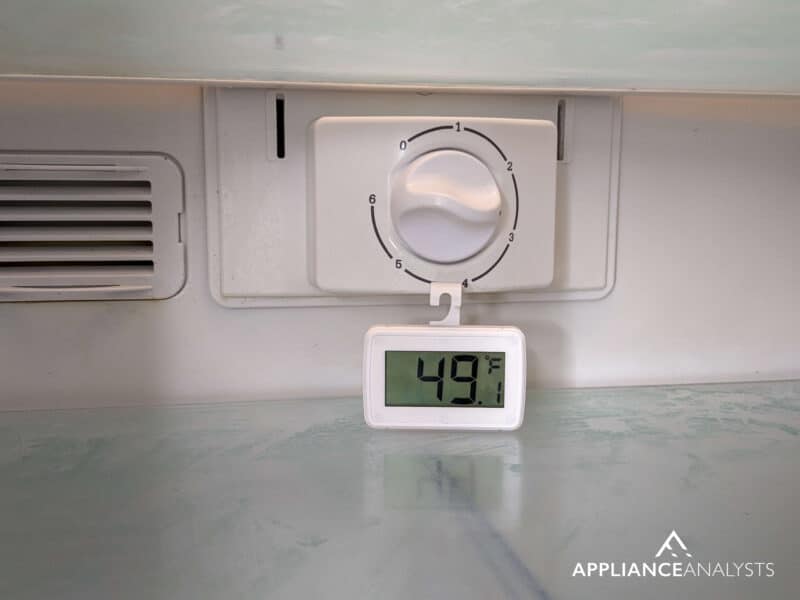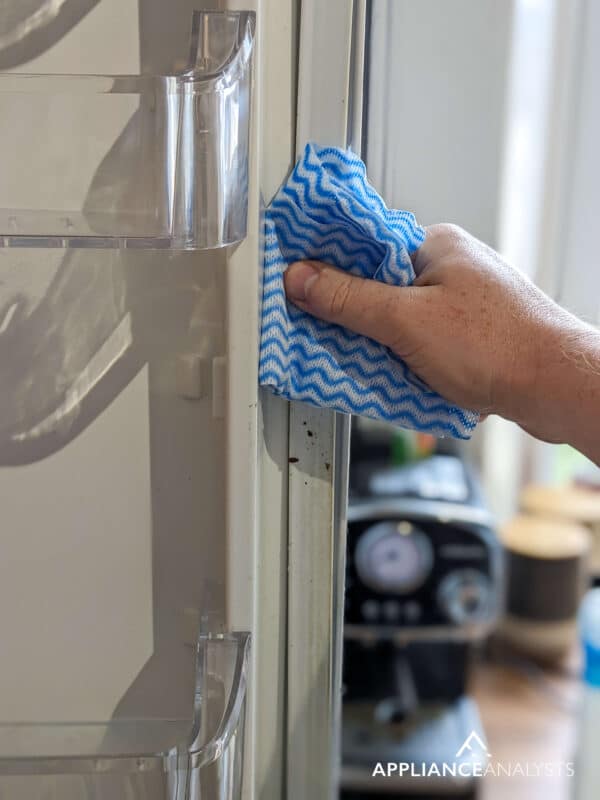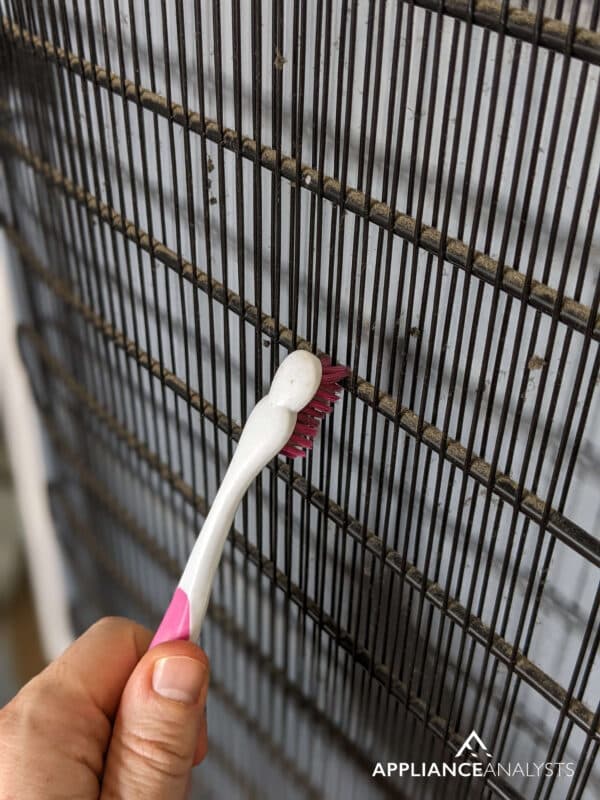We've independently reviewed this article to make sure it's as accurate as we can make it.
To find out more about our article creation and review process, check out our editorial guidelines.
Is the air around your fridge warm?
You’re not alone! Realizing the air around your fridge feels warm can be quite concerning. It’s one of those situations that can make you wonder, “Is this normal?”
Don’t worry, though. I’m here to help you figure it out.
The air around your fridge can feel warm during the cooling process, which is normal. However, if it becomes too hot, consider ambient temperature, ensure proper ventilation space, check the temperature and door seals, and clean the coils. If the issue persists, look into the condenser fan motor.
Read on to learn more about why the exterior of your fridge feels warm!
Why trust us? This article was written by Craig Anderson and Andy Fulenchek.
Craig has helped thousands of other homeowners repair their appliances since 2016.
Andy is one of our resident appliance repair experts with over a decade of experience. He currently runs his appliance repair company with a team of trusted technicians.
Does the Air Around Your Fridge Feel Warm? 6 Fixes
It’s normal for the exterior of your fridge to feel slightly warm during the cooling process. Here’s why:
Inside your fridge, there’s a liquid called “refrigerant” that flows through the unit’s internal coils to absorb the heat and cool your food. Then, it travels through the condenser coils, typically at the back or across the bottom, to release the accumulated heat.

So, when you feel warm air near your fridge, it’s actually a sign that your appliance is doing its job. However, if you find that the air around your fridge feels excessively hot or warmer than usual, here are some steps to address the issue:
#1 Consider Ambient Temperature
When the air around a fridge feels warm, I always consider ambient temperature.
As mentioned above, your fridge transfers heat from the inside to the outside air through the coils. When ambient temperature is around the ideal 70ºF, the heat easily dissipates into the surrounding air.
However, if the ambient temperature is high, the heat doesn’t have a colder place to go. As a result, your fridge will need to work harder to release the accumulated heat, and the air around it can feel warm.
Make sure your fridge is away from heat sources, such as an oven or dishwasher. It’s also important to ensure it’s not in direct sunlight.
If you plan to place your refrigerator in your garage, make sure it’s a “garage-ready” model. These fridges can handle more significant temperature fluctuations.
#2 Ensure Proper Ventilation Space
If the air around your fridge feels warm, please ensure that there is enough breathing room.
Refrigerators need proper ventilation space to allow the condenser coils to dissipate heat effectively. If your fridge is in a tight space, it must work harder to keep the interior cool, making the surrounding area feel warmer than usual.
Additionally, when a fridge doesn’t have enough breathing room, the internal components can start to malfunction, leading to increased running costs.
Carefully move your refrigerator and leave at least 1 or 2 inches (2.54 cm—5 cm) of extra room on each side.

Note: It’s also important to read the manufacturer’s manual, which typically includes specific recommendations to ensure proper ventilation.
#3 Check the Temperature Settings
Now, it’s time to make sure your refrigerator is set to the correct temperature.
Most refrigerators should sit between 3 °C (37.4 °F) and 5 °C (41 °F). If your fridge is too cold, it will need to work harder and run longer to keep the temperature low, which can strain the compressor and make the surrounding air feel warmer.
If your fridge doesn’t have a built-in digital display, you can check its temperature by placing an appliance thermometer inside, away from the door.

If you don’t have an appliance thermometer, I usually advise placing a glass of water on the middle shelf and leaving it there for 8–12 hours. Then, place a regular thermometer in the glass of water and check the temperature.
If your fridge is too cold, please adjust the temperature dial and double-check with the water trick after a few hours.
#4 Examine the Door Seals
In my experience, damaged or worn-out door seals can also explain why the air around your fridge feels warm.
You see, the door gaskets (or seals) are responsible for sealing in the cold air and keeping warm air from entering the fridge. Unfortunately, if the gaskets become loose, broken, or dirty, cold air will escape, and your compressor will need to run more frequently to keep up, making the surrounding air feel warmer.
Dirty or damaged door seals can also lead to frost buildup and other temperature issues, so it’s crucial to solve the issue immediately!
Clean your fridge’s door seals with any general kitchen cleaner or warm water and vinegar. Wipe away any grime or dirt and dry the door gasket with a paper towel to prevent mold.

Avoid using bleach when cleaning your fridge’s door seals, as it can lead to a strong chemical smell.
While you’re at it, please take a closer look at the door gaskets. If you notice they’re worn out, broken, or damaged, please replace them.
#5 Clean the Condenser Coils
If the air around your fridge still feels warm, the condenser coils are probably covered in dust.
As mentioned above, the condenser coils dissipate the heat generated during the cooling process. Unfortunately, if you haven’t cleaned the coils in a while, the heat will accumulate at the back of the bottom of the fridge rather than being released into the environment.
Don’t worry, though. In my opinion, cleaning the condenser coils is super simple. Here’s how to do it:
- Unplug your fridge from the wall outlet and carefully move it to access the condenser coils.
- Take a gentle brush (you can use an old toothbrush) to clean the condenser coils. You can also use a vacuum.
- Use a damp cloth to wipe down the condenser coils.
- Use a dry cloth or paper towels to dry the coils.

While you’re at it, please clean behind and below your fridge to keep dust to a minimum and ensure your fridge’s effectiveness. You can vacuum and mop using a commercial cleaner or vinegar (please avoid using bleach). Remember to allow the area to completely dry before moving your fridge back to its original spot.
#6 Check the Condenser Fan Motor
If you’ve tried all the fixes above, but the air around your fridge still feels warm, you must inspect the condenser fan motor.
Your refrigerator’s condenser fan motor is located near the condenser coils. It is responsible for blowing air over the coils to help dissipate heat. Unfortunately, if the condenser fan motor malfunctions, you’ll notice that the air around your fridge or door frame is warmer than usual.

Please unplug your fridge from the wall outlet and access the condenser fan motor. It should be able to spin freely by hand.
If the fan doesn’t spin, you can use a multimeter to test for voltage. In my experience, it should read around 110 volts AC for most models. Keep in mind that newer models use a DC fan motor that takes 12 to 13 volts DC.
If the condenser fan motor is not working, please replace it with a new one. While you wait for the replacement part, you can use a regular box fan as a temporary measure to help cool the condenser coils.
Wrapping Up: Steps to Address a Warm Fridge Exterior
Hopefully, now you know how to fix your fridge’s issues.
Remember that if the air around your fridge feels warm, you’ll need to place it away from heat sources, such as an oven. It’s also important to leave at least 1 or 2 inches of extra room on each side of your refrigerator to ensure proper ventilation.
Don’t forget to make sure your fridge is set to the correct temperature, examine the door seals, clean the condenser coils, and inspect the condenser fan motor.
Thank you so much for taking the time to read this article. If you ever experience a different issue with your refrigerator, please check out our site. You’ll find multiple guides that will help you fix it.
Have a wonderful day!









